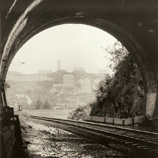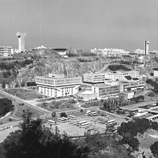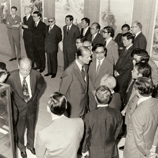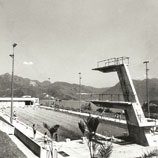

1973 - 1982
The second decade of the University's existence coincided with a rapidly changing period in world history. There was economic upheaval caused by the oil crisis. Large shifts in people's social values and attitudes were also evident. In Hong Kong it was a time of booming economic growth with an annual GDP of over 8 per cent, helping it become one of the 'Asian Tigers' and a global financial hub. Changes were also afoot in Hong Kong society. The government's implementation of the New Town Development Programme in 1973 led to the tremendous pace of transformation and urbanization of several new towns in the following decade, including the small neighbouring rural township of Shatin.
It was against this backdrop that the third report on the development of CUHK by the founding Vice-Chancellor, Dr. Choh-ming Li, was published. Aptly titled 'A New Era Begins 1975–1978', it signified the development and expansion of the University during its second decade of existence, and the challenges it faced in responding dynamically to the needs of the local community and external economic pressures while staying true to the vision, objectives and aspirations on which the University was founded. The report also symbolized the passing of the torch as Professor Ma Lin took the reins as the University's Vice-Chancellor after the retirement of Dr. Li in 1978.
Much of the impetus for the 'new era' came from the second Fulton Report, a seminal document that laid down the foundations for the present-day organization and structure of the University. In its formative years the University was a loose federation of individual Colleges, each with its own teaching departments and staff. The most important recommendations in the Report, which were later enacted into law through The Chinese University of Hong Kong Ordinance 1976, called for the formalization of the university college relationship and setting the respective roles of the University and the Colleges. Academic departments from different Colleges were integrated under the University as part of its role to provide 'subject orientated teaching'. Teaching and staffing fell under the purview of the University, leading to better resource management and ability to set long-term goals for future growth. One concrete example of such consolidation was the development of educational pedagogy and the increasing use of instructional equipment to make teaching more professional and engaging.
The redefined role of the Colleges was to provide 'student orientated teaching' by fostering the intellectual, moral and personal development of students. This included the provision of communal living spaces, pastoral and counselling support, greater teacher student interactions, as well as social and athletic activities that engendered camaraderie among students. This unique arrangement, which is still practised to the present day and which distinguishes CUHK from other universities in Hong Kong, provided a balance of knowledge transmission through formal teaching and learning, and student empowerment to engage in the process of self-discovery.
The Report also emphasized the continuity of CUHK's aspiration to be an international university that integrates Chinese and Western intellectual and cultural traditions. This is best exemplified by the work of the Institute of Chinese Studies. Established in 1967, the Institute continued its objective to be an international centre for the promotion and study of Chinese culture. Along with its regular exhibitions, workshops and conferences, 1973 saw the inauguration of Renditions, a Chinese-English translation journal that featured the most enduring Chinese writings rendered into English and made available to an international readership.
In its short time as a research institution, the University not only made important advances to the knowledge of Chinese studies, but also in other disciplines with research on Chinese medicinal herbs, food proteins, social life in Hong Kong, machine translation, teaching pedagogy, and economics, among others. The dissemination of scholarship was further enhanced with the establishment of the Chinese University Press in 1977, which has since developed into a reputable publisher of scholarly works, with a unique edge in Chinese culture and Hong Kong studies, as well as books of general and educational interest and electronic publications. Today, the Press publishes more than 50 titles a year and carries well over 1,300 titles in its backlist.
In keeping with the mission of promoting cultural exchange between East and West, the International Asian Studies Programme was launched in 1977 with the support of the Yale- China Association, and provided students from outside Hong Kong with opportunities to deepen their knowledge of Chinese and Asian studies by living, studying and conducting research in a Chinese setting.
Of course, the decade of growth of the University would not be possible without the concurrent development and expansion of its campus. Throughout the decade many prominent buildings were constructed and helped to transform the face of the mountains. These include the Sir Run Run Shaw Hall, the University Sports Centre, the Choh-Ming Li Basic Medical Sciences Building, and the postgraduate hall complex. New student hostels were also constructed for each of the three constituent Colleges.
In 1974 the university pylon was erected at the main entrance to the University, consisting of four stone pillars and a sign bearing the name of the University. With no gates or barriers, the pylon symbolized the University's connection to the community and its commitment to public service. Indeed, the founding of the Faculty of Business Administration (1974) and the Medical School (1981) was due in large part to the demand for trained management and medical personnel for Hong Kong's growing economy and increasing population. The same decade also saw the launch of the University's first PhD programmes in Chinese Studies and Electronics and other academic programmes such as anthropology and psychology.
These developments during the second decade showed that the University was not only committed to the development of Hong Kong. It was also taking its first steps to becoming a truly international and comprehensive university.



































CUHK Research | CUHK: Focus at 50 | The Call of CUHK Colleges
CUHK Home | ISO Home | Contact Us | Disclaimer | Privacy Policy
Copyright © 2022. All Rights Reserved. The Chinese University of Hong Kong.